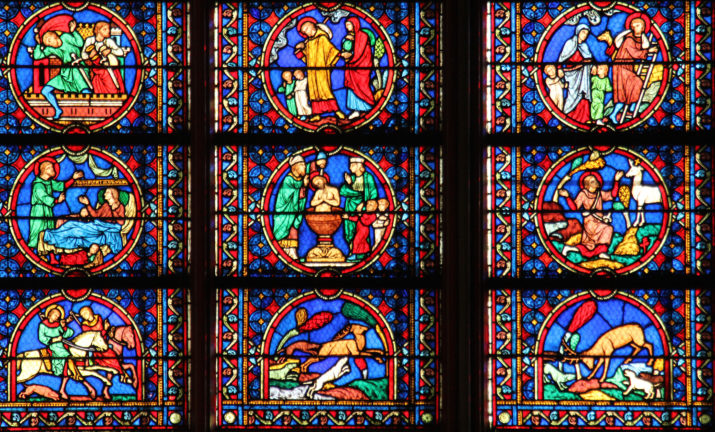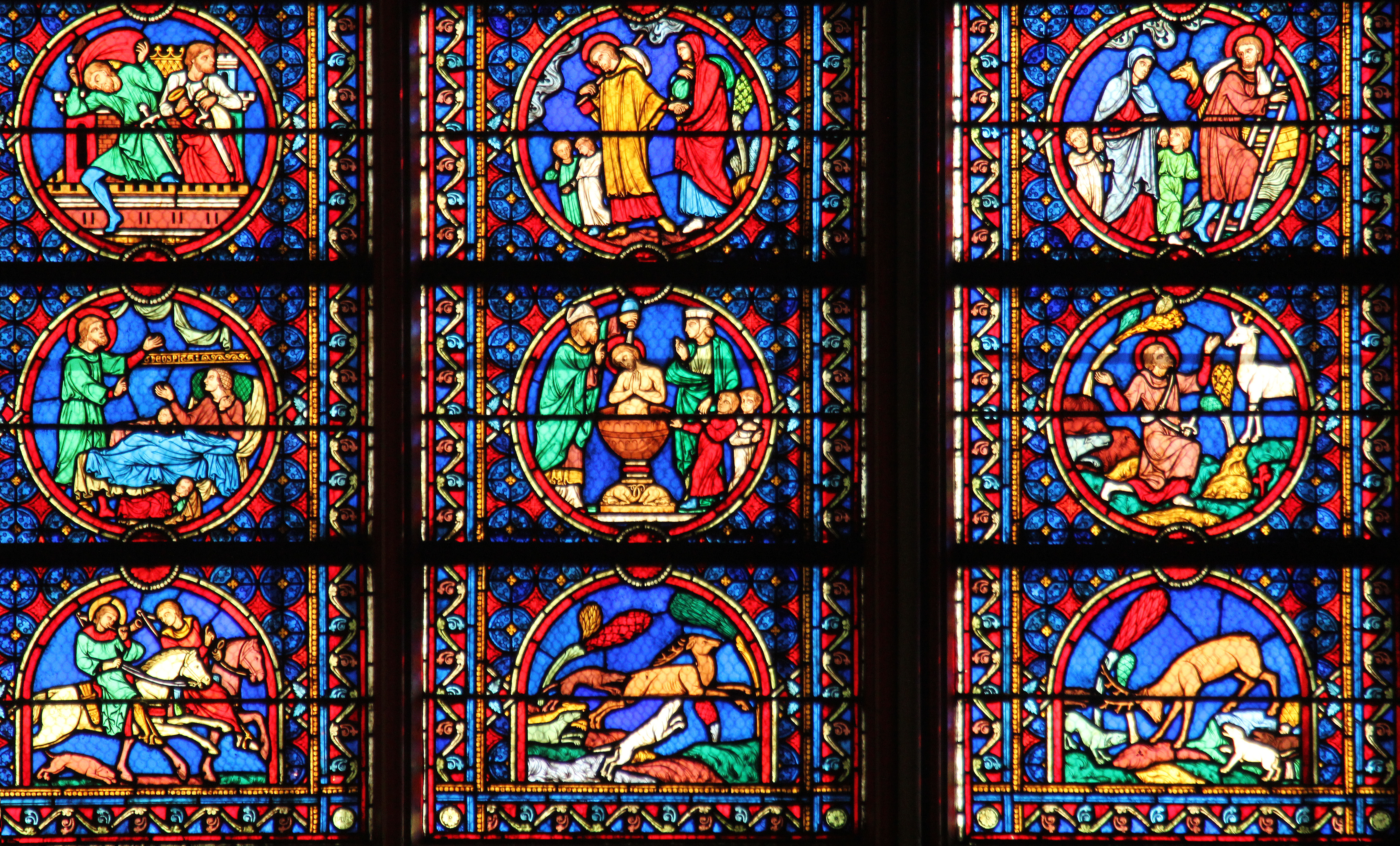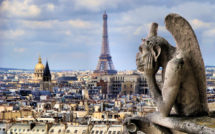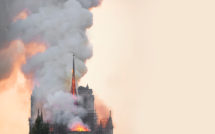
The Mobilization of Identity Around Notre-Dame de Paris and the Danger of Christian Nationalism

This is part of a roundtable on Notre-Dame de Paris.
On the night of April 15, 2019, as a blazing fire destroyed the roof and spire of Notre-Dame de Paris, stunned observers and commentators attempted to describe the historical and symbolic importance of the monument for television cameras that were broadcasting the events live across the world. Because the cathedral is one of the most iconic landmarks of the city of Paris, and the most visited monument in Western Europe, a significant number of people around the world have strong attachments to it, often tied to their own experiences visiting Paris. This is the case as well for the French, including most Parisians, for whom the cathedral is an architectural and historical monument—a piece of the landscape—rather than a religious space. Indeed, Notre-Dame is the parish church for very few French Catholics. And although it remains a sacred space that celebrates 2,000 religious services per year and houses important Catholic relics as well as the cathedra of the Archbishop of Paris, for the vast majority of the nearly thirteen million annual visitors, the cathedral is less of a religious pilgrimage than an exceptional opportunity to observe rare medieval Gothic architecture and its famous stained glass rose windows.[1] Some commentators have suggested that the cathedral is much more than just a beautiful building, and that its very existence stands as a key symbol of “Western civilization.”[2] Many others, including French President Emmanuel Macron, who vowed to rebuild the cathedral, have emphasized the centrality of the church to French history and identity.[3]
It is only natural that the fire at Notre-Dame would lead us to reflect on the cathedral’s position and legacy within French and global society. However, it is also important to recognize that the discourses around the cathedral and its place in history that privilege its symbolic relationship to France’s “Christian” heritage, or that define the religious edifice as emblematic of “Western civilization,” promote a narrow and divisive vision of Frenchness that does little to unify the nation, but instead further divides it. On the one hand, both of these discourses tend to ignore the complex history of church-state relations in modern French history and erase the role of Islamic art and culture in medieval Europe. Furthermore, throughout modern history, the nationalist conflation of Christianity and Frenchness has often served to justify xenophobic politics in France. From the outbreak of the fire, numerous individuals and groups have sought to mobilize the destruction of Notre-Dame to serve comparable political ends.[4] Consequently, framing the fire at Notre-Dame only as a “loss” ignores the long history of monuments and the vicissitudes of their materially precarious lives that we take to be transhistorical. Yet, this “loss” also provides an opportunity for us to engage in a critical dialogue about the historical and contemporary relationship between religion and politics in France and the broader world and how monuments of the past are mobilized to justify the policies of the present.
The contemporary relationship between church and state in France is quite distinctive. It is defined by a concept known as laïcité, the French version of secularism, which considers religion a private affair to be kept completely outside the public sphere. The practice of separating church and state emerged in France during the French Revolution (1789-1799), when the rising tide of anti-clerical fervor saw the newly established French Republic seize the property of the Catholic Church, including Notre-Dame de Paris. However, the relationship between politics and religion in France has only grown more complex over time. Relations between the French and the Catholic Church were somewhat repaired by Napoleon I, who notably crowned himself emperor in Notre-Dame in 1804. However, during the nineteenth century, liberal republicans continued to view Catholicism (and many Catholics’ open support for the monarchy) as a danger to the secular ideals of the Enlightenment and the French model of republicanism. On the other hand, the post-revolutionary “Romantic Catholics” believed it was possible to be loyal to both France and Rome.[5] By the end of the century, Catholic monarchists, including influential journalists, were key members of far-right political movements that challenged the legitimacy of the French Third Republic (1871-1940); several of their most well-known publications were also known for their virulent anti-Semitism. The latter reached its peak with the Dreyfus Affair in the 1890s, destroying any goodwill between republicans and Catholics.[6] When radical republicans came to power at the turn of the century, they sought to defend the Republic against its most visible enemy, the Catholic Church. They did so by instituting a number of laws between 1901 and 1905 to consolidate the legal separation of church and state. The 1901 Law on Associations dismantled Catholic congregations, while a 1904 law forbade Catholic congregations from teaching, which led to the closing of more than 3,000 Catholic schools. The well-known 1905 Briand law declared that the French Republic would not provide salaries or subventions to any religious organization. It also announced that ownership of all church property built before that date would be transferred to the French state and local governments. This provision helps explain Notre-Dame de Paris’s current state of disrepair as the cathedral itself is owned by the French state and leased to the French Catholic Church. However, disputes over who should finance its upkeep and repairs date back to the 1800s.[7]
During the twentieth century, relations between the Catholic Church and the French state steadily improved, beginning when Catholics rallied to support the nation during World War I in a truce known as the “sacred union.” When the Vichy government came to power in 1940, it seemed the tide had turned in favor of conservative Catholics. With the support of the Catholic Maréchal Philippe Pétain at the head of the regime, Vichy officials instituted the National Revolution to reinject religion back into the state and overturn the legacy of the secularization policies of the Third Republic. Although the regime would fall and a new republic emerge after World War II, postwar France became a site of an invigorated Catholicism in the public sphere. A newly formed Christian Democratic political party (the Mouvement républicain populaire) shaped state policy, while the blossoming leftist Catholic intellectual sphere became globally influential. Additionally, French Catholics played key roles in France’s most significant post-WWII political drama, the Algerian War of Independence (1954-1962).
Another key factor that has shaped religious policy in modern France is the French overseas empire and the migration and settlement of formerly colonized populations in France, particularly since 1940. Although scholars and observers note a significant decline in church attendance among Christians in France by the mid-1960s (in part due to the religious and moral elements of the Algerian War), religion remained a major topic of public discussion in France.[8] But the focus shifted from the relationship between Christianity and the state to the place of Muslims within the French nation, particularly as growing numbers of immigrants from former French colonies (especially Algeria, Morocco, and Tunisia) came to France as labor migrants or as permanent immigrants in the 1960s and 70s. During the 1970s, far-right anti-immigration rhetoric specifically targeted Arab males and Muslim populations in France, claiming that these groups were dangerous to white, Christian French citizens, especially women.[9] In the late 1980s, a neo-republican political movement would rally around the first of several “affaires du foulard” (or “headscarf affairs”) to reclaim the mantle of laïcité as a cornerstone of French republicanism, this time targeted not at a reactionary Catholicism but at Islam and its supposed incompatibility with French republican values.[10]
As scholars of contemporary secularism have observed, political discourses of secularism and their applications are products of Christian cultures, even when they claim to be supporting religious liberty.[11] In the specific case of France, despite very vocal pronouncements by state officials proclaiming the French state’s full commitment to laïcité, Christian religious holidays, dietary rituals, and religious spaces have been normalized as “French” and therefore universal (with space for them built into the official systems of education and state bureaucracy). Those of other faiths are seen as “other” and foreign to Frenchness. Additionally, scholars such as anthropologist Elayne Oliphant have shown that in contemporary France, Catholicism (and specifically Catholic religious edifices and medieval art) have become a totem for “high culture,” a situation that has led to a secularization of Catholic visual culture and Catholic churches themselves.[12] A study in 2017 noted that only around 1.8 percent of the population could be described as “practicing” Catholics (i.e. those who regularly attend Sunday mass). As Carol Ferrara notes in her essay in this roundtable, with the massive decline of church-going among Catholics in France, French Catholicism has come to represent a “cultural” idea, rather than a religious belief, and for some this idea is closely tied to a European or a national identity (or even more ambiguously to the problematic concept of “Western civilization”).[13] But there is a danger in this kind of ethno-religious identification. The example of how Christianity functioned in French colonial Algeria illustrates that despite the French state’s claims to secularism as a republican value that promotes national unity, the French have long wielded institutional symbols of Christianity, particularly against Muslims, as a means to police access to French citizenship and to the social and cultural benefits of “Frenchness.”
Although the Catholic Church and the French state did not always see eye-to-eye on what role the church should play in the overseas empire, the two institutions were deeply intertwined in Algeria from the moment that the French army landed on Algerian soil in 1830. Immediately after the invasion and conquest of the territory, French Catholics began enthusiastically converting mosques into Catholic churches, a symbolic and physical act they proclaimed was necessary to restore the ancestral homeland of Saint Augustine from the heathen Arabs and Berbers. At the same time in Notre-Dame de Paris, they celebrated their victory with a Te Deum Mass.[14] To solidify its hold on the unruly colony, in 1848, the French had declared the three northern departments of Algeria to be part of France. Notoriously violent tactics of population displacement and outright theft of indigenous land enabled the French to establish a settler colony there, whose population was a diverse mixture of migrants from around the Mediterranean—Spanish, Italian, Maltese, and French—the vast majority of whom were Catholic by culture if not in practice. The Catholic Church in Algeria, whose dioceses were attached to France, had initially engaged in some missionary outreach to the Muslim population, but it was quite limited compared to other colonies. Indeed, after earlier failures at converting Algerian Muslims, in 1868, the Archbishop of Algiers, Cardinal Lavigerie, created a missionary order known commonly as the White Fathers specifically to convert Berber Kabyles to Christianity. Consistent with the “Kabyle myth,” the French claimed that this population’s supposed ancestral connections to the Berber Catholic Saint Augustine and ethno-religious distinctions from Arab Muslims were traits that made them more receptive to conversion.[15]
Despite its claims that Algeria was legally part of France, the French government enacted religious policies in Algeria that differed significantly from those of metropolitan France, and the Catholic Church followed suit. By the turn of the twentieth century, the Algerian Catholic Church was an institution whose primary focus was on the settler population. To protect its property and ensure its presence in the colonial setting, the Catholic Church had entered into a close and mutually beneficial relationship with the French colonial powers, even at the height of the secularization campaigns of the Third Republic. Additionally, “Christianity” and its related symbolism had become a marker of European identity in Algeria. These symbols included Catholic churches, religious pilgrimages and ceremonies (notably to Ancient Roman sites such as Tipaza or Hippo), church bells, and the organization of time and space around the liturgical calendar. This identity was then framed in opposition to the “indigenous” Arab and Berber populations who were continually denied rights due to their perceived backwardness and attachment to Islam.
The Algerian War of Independence was consequently viewed as a religious conflict and was central in reshaping the relationship between Christianity, nationalism, and politics in both Algeria and France.[16] When the war began in 1954, almost immediately those who sought to maintain Algeria as part of France began using rhetoric that depicted the fight to suppress Algerian nationalism and the violent tactics of French “pacification” (including the use of torture) as necessary to “defend Christian civilization” in Algeria. The politics and violence of the war tore apart the Catholic community of Algeria; the vast majority of Christians in Algeria supported the cause of French Algeria against a small minority who they labeled as traitors to both France and Christianity for their willingness to engage in dialogue with the Algerian Muslims, and in some cases, to openly work toward Algerian independence. The war also had devastating effects on Christianity in France. The ecclesiastical leadership bodies of the French Catholic and Protestant churches were notoriously hesitant to take a public position on the war and specifically the violence committed by the military and police against Algerian nationalists and their supporters. Many Christians in France who were drafted into the French army and sent to Algeria sought guidance from ecclesiastical leaders on what to do when asked to commit acts such as torture, which they believed went against their Christian conscience. They often felt that they had been abandoned by the church. Meanwhile General Massu, the Catholic head of the infamous paratrooper division in Algiers, commanded his army chaplain to write a theological treatise defending the use of torture to “ease troubled consciences.”
By the war’s conclusion in 1962, many feared that Christians would be expelled from the country en masse by the new Algerian government due to the growing violence and tensions between the Christian and Muslim communities in Algeria. However, this is not what took place at independence. Although the vast majority of the European settler population did leave Algeria, the reasons were more complicated. A visible minority of the Christian population remained in Algeria at independence; many of these Christians had been politically and socially engaged on behalf of the Algerian population during the war. As a result of these efforts, the Algerians were happy to let them stay (indeed many became active figures in the effort to construct postcolonial Algeria). In negotiating their place in newly independent Algeria, Catholic leaders undertook several symbolic actions to demonstrate their attempts to sever the connection between the church and the French colonial regime. The most well-known of these actions was the return of the St. Philippe Cathedral in Algiers to the Algerian state. This cathedral at the foot of the casbah of Algiers had been an Ottoman-era mosque before the French transformed it into a cathedral in the 1830s and made it the seat of the Archbishop of Algiers. In 1962, it was transformed back into a mosque.
Although today’s political circumstances are very different from those facing Catholics in Algeria in 1962, the fire at Notre-Dame offers both Christians and non-Christians alike the opportunity to reflect on our individual and societal relationships to the cathedral but also to reconsider the status of laïcité in France, its complex history, and how our discourses about religion and society shape larger political practices and political culture. At this moment of rising tensions in France around issues of economic justice, police violence against protestors and non-white citizens, treatment of refugees and migrants as well as growing xenophobia, discourses that frame the French nation in exclusionary language are hardly neutral. Some far-right commentators around the world have suggested, for example, that French Muslims were responsible for the Notre-Dame fire, as they had been for numerous other attacks on Christian churches in France. These discourses play directly into ideologies that have, since the 1970s in France, depicted non-Christian immigrant populations as an “invading horde” that will overcome and destroy the white, Christian French.[17] They sow further divisions between Christian and Muslim communities, many of which have festered since the brutal war of Algerian independence.[18] The cathedral of Notre-Dame de Paris is a unique monument to France and to the world, and perhaps more significantly, it is a singularly beautiful and historic Christian church, whose historical and symbolic importance we can commemorate and value without also instrumentalizing it as a political tool of racism and xenophobia.
Darcie Fontaine is an Associate Professor of History at the University of South Florida. Her first book Decolonizing Christianity: Religion and the End of Empire in France and Algeria was published in 2016 by Cambridge University Press. She is currently researching the French aid organization Cimade and completing a textbook on the history of the modern French empire.
[1] For a brief history of Notre-Dame de Paris and statistics on the number of annual visitors, see Karen Zraick and Heather Murphy, “Notre-Dame Cathedral: Facts and a Brief History,” The New York Times, April 15, 2019 https://www.nytimes.com/2019/04/15/world/europe/notre-dame-cathedral-facts.html (accessed May 14, 2019).
[2] Some examples of this narrative include Victor Davis Hanson, “The Cathedral: Mirror of the West, Then and Now,” National Review, April 23, 2019 https://www.nationalreview.com/2019/04/notre-dame-cathedral-fire-religion-decline-western-civilization/ (accessed May 14, 2019); Rod Dreher, “Notre Dame Fire: A Sign For Our Time,” The American Conservative, April 15, 2019 https://www.theamericanconservative.com/dreher/notre-dame-de-paris-sign-of-the-times/ (accessed May 14, 2019); and John Daniel Davidson, “Notre Dame Isn’t Just A Symbol Of Western Civilization, It’s A Symbol Of Heaven,” The Federalist https://thefederalist.com/2019/04/17/notre-dame-isnt-just-symbol-western-civilization-symbol-heaven/ (accessed May 14, 2019).
[3] “Notre-Dame de Paris: le résumé du discours d’Emmanuel Macron,” Le Monde, April 16, 2019 https://www.lemonde.fr/societe/video/2019/04/16/notre-dame-de-paris-le-resume-du-discours-d-emmanuel-macron_5451201_3224.html (accessed May 15, 2019).
[4] See, for example, “Alt-right spreads anti-Muslim rhetoric after Notre Dame fire,” Al Jazeera, April 16, 2019 https://www.aljazeera.com/news/2019/04/alt-spread-anti-muslim-rhetoric-notre-dame-fire-190416110146645.html (accessed May 15, 2019).
[5] See Carol E. Harrison, Romantic Catholics: France’s Postrevolutionary Generation in Search of a Modern Faith (Ithaca: Cornell University Press, 2014).
[6] Scholar Vicki Caron is currently undertaking a major study of Jewish-Catholic relations and Catholic anti-Semitism in France between 1870 and 1914. See her article “Catholic Political Mobilization and Anti-Semitic Violence in Fin-de-Siècle France: The Case of the Union Nationale,” Journal of Modern History 81, 2 (June 2009): 294-346.
[7] On the cathedral’s state of disrepair before the fire and challenges to find funding, see Valentina Pop, Drew Hinshaw, and Nick Kostov, “Decades of Neglect Threatened Notre Dame, Well Before It Burned,” The Wall Street Journal, April 21, 2019 https://www.msn.com/en-us/news/world/decades-of-neglect-threatened-notre-dame-well-before-it-burned/ar-BBW5bxS (accessed May 14, 2019).
[8] See Hugh McLeod and Werner Ustorf, eds., The Decline of Christendom in Western Europe, 1750-2000 (Cambridge: Cambridge University Press, 2003), especially essays by Hugh McLeod and Callum Brown; and Hugh McLeod, The Religious Crisis of the 1960s (Oxford: Oxford University Press, 2007); on the impact of decolonization on French Catholicism after 1962, see relevant chapters in Denis Pelletier and Jean-Louis Schlegel, eds., À la gauche du Christ: Les chrétiens de gauche en France de 1945 à nos jours (Paris: Editions du Seuil, 2012).
[9] See Todd Shepard, Sex, France & Arab Men, 1962-1979 (Chicago: University of Chicago Press, 2018).
[10] On France’s headscarf laws and laïcité, see Joan W. Scott, The Politics of the Veil (Princeton: Princeton University Press, 2010); Emile Chabal, A Divided Republic: Nation, State and Citizenship in Contemporary France (Cambridge: Cambridge University Press, 2015), chapter 3; and Mayanthi Fernando, The Republic Unsettled: Muslim French and the Contradictions of Secularism (Durham and London: Duke University Press, 2014).
[11] See David Martin, On Secularization: Towards a Revised General Theory (London: Ashgate, 2005) and Charles Taylor, A Secular Age (Cambridge, MA: Harvard University Press, 2007).
[12] Elayne Oliphant, “Beyond blasphemy or devotion: art, the secular, and Catholicism in Paris,” Journal of the Royal Anthropological Institute 21, 2 (2015): 352-373.
[13] See Carol Ferrara’s essay in this roundtable on Notre-Dame, “Secular France’s Cultural Catholicism and its Muslim Citizens” (EuropeNow Journal, 2019) for a summary of her research on how Catholic and Muslim French citizens are positioned in relation to French national identity. According to a sociological study published in 2017, although 53% of the French population describe themselves as Catholics, only 23% could be described as “involved” Catholics who are actively involved with the Church and the culture of Catholicism, and those who are “practicing” (e.g. regularly attend Sunday Mass) are only around 1.8% of the population. The study was commissioned by the Bayard Group and published jointly by the French Catholic newspapers La Croix and Pèlerin. A summary of the survey results in English can be found here: https://international.la-croix.com/news/the-sociology-of-french-catholics/4491 (accessed May 14, 2019).
[14] Jennifer Sessions, By Sword and Plow: France and the Conquest of Algeria (Ithaca, NY: Cornell University Press, 2011), 43-44.
[15] On the “Kabyle Myth,” see Patricia M.E. Lorcin, Imperial Identities: Stereotyping, Prejudice and Race in Colonial Algeria (London: I.B. Tauris, 1995), 62-63, 179.
[16] On the history of Christianity in colonial Algeria and during the Algerian War of Independence, see Darcie Fontaine, Decolonizing Christianity: Religion and the End of Empire in France and Algeria (New York: Cambridge University Press, 2016).
[17] See, for example, Chelsea Stieber’s analysis of the influence of Jean Raspail’s 1973 novel Le Camp des saints on France and far-right movements globally and notably its influence on discourses of immigrant “invasions,” in “Camp of the Saints,” Africa is a Country, March, 17, 2019 https://africasacountry.com/2019/03/camp-of-the-saints (accessed May 28, 2019).
[18] See Jane Lytvynenko and Craig Silverman, “A Timeline of How the Notre Dame Fire Was Turned Into An Anti-Muslim Narrative,” BuzzFeed News, April 16, 2019 https://www.buzzfeednews.com/article/janelytvynenko/notre-dame-hoax-timeline (accessed May 15, 2019).
Photo: PARIS, FRANCE – NOVEMBER 05, 2012: famous Notre Dame cathedral stained glass. UNESCO World Heritage Site | Shutterstock Published on October 2, 2019.




